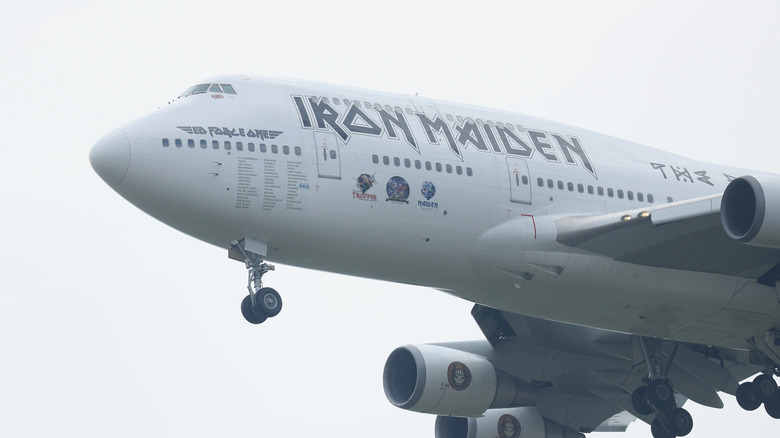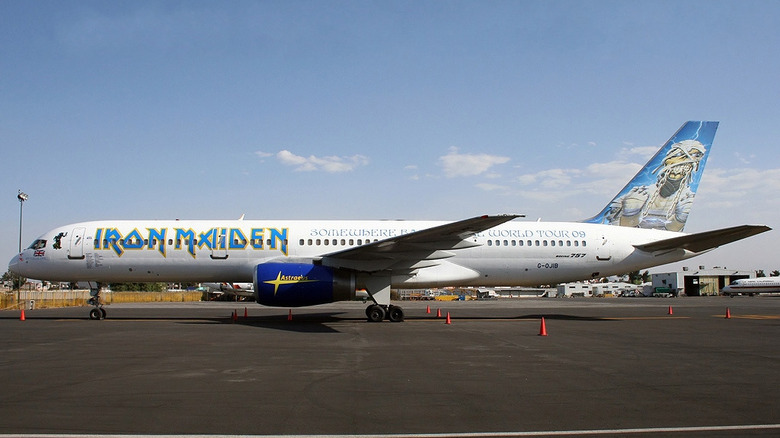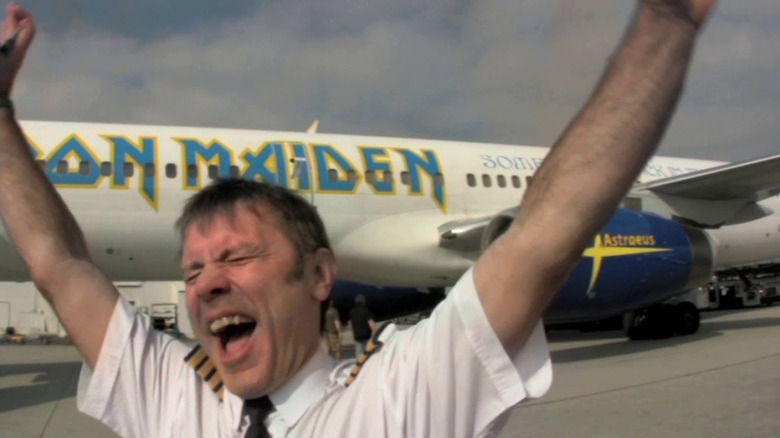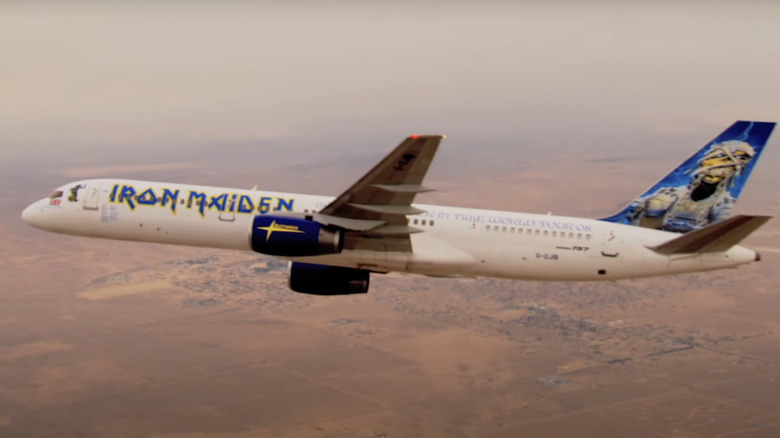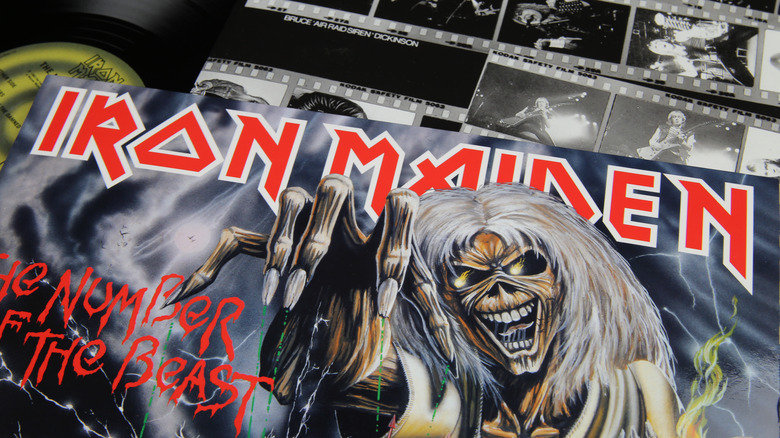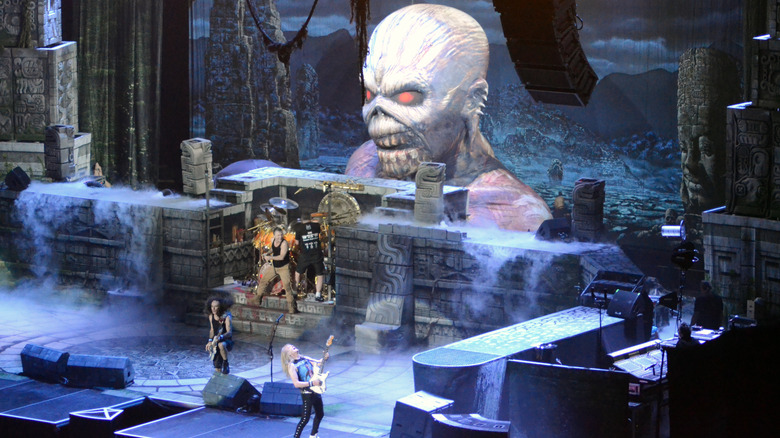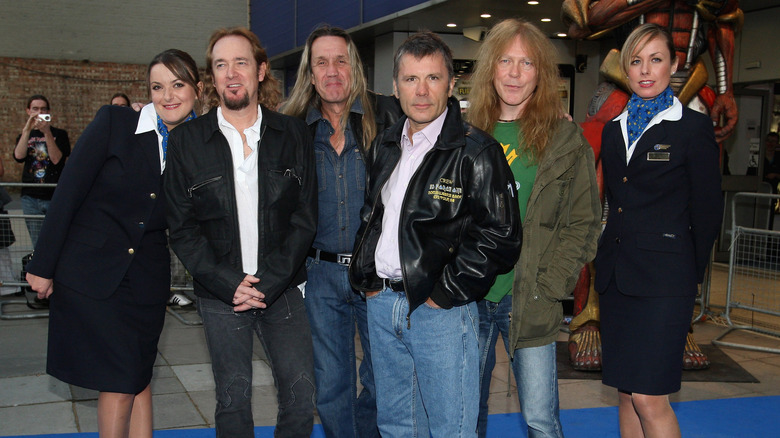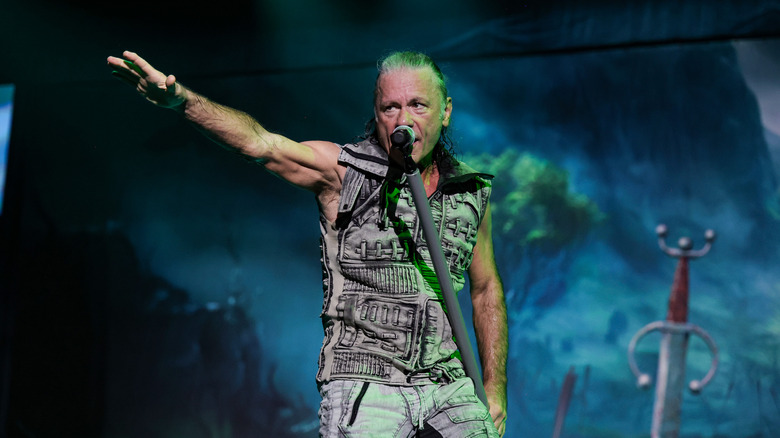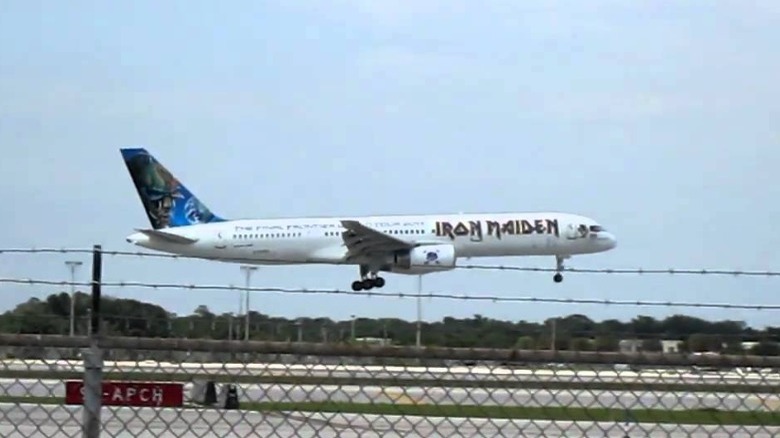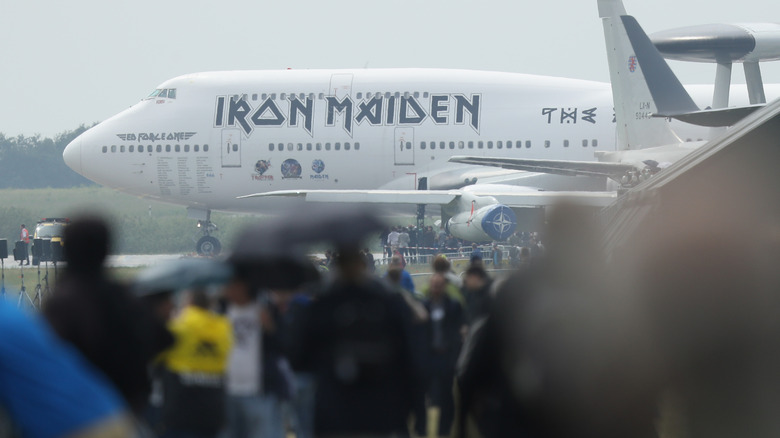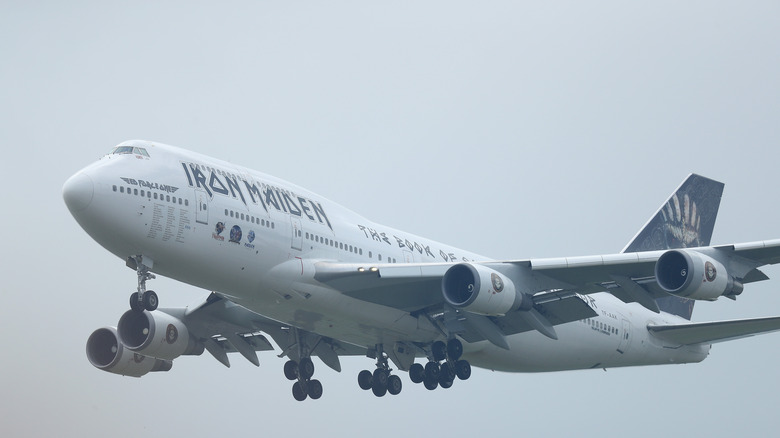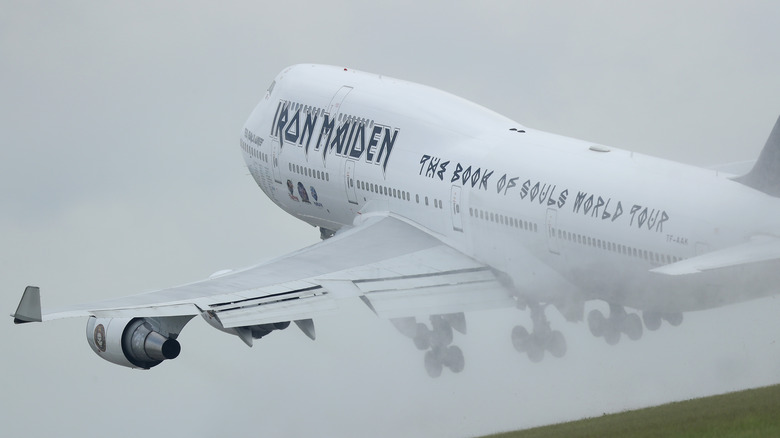Everything To Know About The Iron Maiden 'Ed Force One' 747 Jet
Most people are familiar with aircraft such as the Boeing 757 and the Boeing 747 — one of the most iconic airplanes in aviation history — as airliners carrying hundreds of passengers to destinations around the world. Of course, there are some very rich individuals who can afford their own aircraft, but these celebrity private jets are usually only used sparingly and often seen as a huge excess as they transport only a few people.
In the last two decades, though, British heavy metal band Iron Maiden has taken a different approach to private jets. Leasing aircraft from a variety of different airline companies, the band has been able to travel around the world with all of its crew and equipment to reach new destinations and make the entire process more efficient than ever before.
Dubbed Ed Force One, the band's own private jet has a long history and you might be surprised to learn these interesting facts about it.
The band's first plane was a Boeing 757-200
Iron Maiden has actually used several aircraft, with different planes taking on the moniker of Ed Force One over the years. The first example of this was a Boeing 757-200 — the same kind of private jet used by Donald Trump — which the band used between 2008 and 2009 as part of the "Somewhere Back in Time" World Tour. This version of the famous 757 jet first entered service in 1983 and the 757-200 variant is the original version of the passenger plane that
What you need to know about the Boeing 757 is that it is the successor to the iconic Boeing 747. It is powered by Rolls-Royce RB211-535C engines and has a maximum range in excess of 4,400 miles alongside a top speed of some 600 mph. With a maximum payload of over 57,000 pounds, the 757-200 can carry a huge amount of cargo and passengers over vast distances without the need to refuel.
The Boeing 757-200 used by the band was chartered from Astraeus Airlines and had the tail number G-OJIB. The British-based airline was founded in 2002 and ultimately ceased operating in 2011 after entering administration. The company notably offered chartered flights to a variety of high-profile clients, including prominent soccer teams such as Arsenal and Manchester United.
Featured image by André Du-pont (Mexico Air Spotters) via Wikimedia Commons | Cropped and scaled | GFDL 1.2]
The aircraft used its Iron Maiden imagery after the tour
Ed Force One was not a standard private jet. The aircraft had a distinctive livery that made it instantly recognizable to fans. The plane had the band's name and logo across its body and a version of the mascot Eddie on the tail fin, while the engines were also colored blue to match the color scheme.
Iron Maiden frontman Bruce Dickinson explained that the aircraft went through painting and safety checks in the months leading up to the tour starting in February 2008. "It will go in for overhaul, painting and conversion in November which will then give us time to ensure we have all the necessary safety documentation, especially with regard to fire safety," he said in a press release posted on Metal Storm. "It also means it could possibly be flying commercial air routes decked out in Maiden colours for a couple of months before we start!"
This paint job stayed on the Boeing 757-200 for several months after the tour, allowing normal passengers to experience it firsthand. Apparently, the design received positive feedback flying in Europe, but it had to be removed when the plane began flying routes into African countries. Speaking to Blabbermouth about the change, Dickinson said: "[The jet] was the only plane available from the Astraeus fleet to fly a new and regular route into and out of an African country on a recent new route. The striking Iron Maiden imagery had a violent reaction from the locals."
The Boeing 757-200 used a combi-configuration
One of the main advantages of using a private jet compared to traditional methods of travel while touring was that it allowed the band to carry a lot of equipment and the crew together all in one place. The Boeing 757-200 that Iron Maiden chartered from Astraeus Airlines had to be converted into a combi-configuration for this purpose, giving it a larger cargo deck and less space for passengers compared to the standard configuration used by airliners.
"Looking at the list of places we would like to play we have always had problems joining up the dots," singer Bruce Dickinson said in a press release posted to Metal Storm. "With sea containers in various places it slows down the whole touring process, which is fine if you want a holiday but not if you want to play. It's great to see places but we don't want to sit around for a week waiting for gear to get from, say, Australia to South America."
Meanwhile, band leader Steve Harris explained that using the private jet gave the band the opportunity to create a bigger and more spectacular stage for shows. Speaking in the same release he said: "Taking our own 757 really makes it a lot more flexible for us and we intend to ram into the specially constructed cargo holds as much of the show as we possibly can."
The name was chosen via a fan competition
When Iron Maiden chartered the Boeing 757-200, the plane didn't immediately have a name, and the band decided to hand over that responsibility to its own fans. Over 2,000 people ultimately submitted names for the jet. The winning suggestion was the name "Ed Force One" in reference to the band's famous mascot, who appears in almost all of its artwork and merchandise, as well as the call sign for the aircraft carrying the President of the United States.
According to the band, many of the submissions from fans featured the same name — or at least similar variations — demonstrating that this was the most popular choice. The winner, known as Wilson, was picked out because he accompanied his suggestion with the comment "Timeless, inspirational, continually evolving, but always true to themselves, camaraderie that survives the evil that men do!"
Having been chosen, the band rewarded Wilson with some prizes. He received backstage passes to see Iron Maiden on the tour and an official tour jacket used by the crew. Finally, he also got a special signed picture of the plane to commemorate the fact that he named it.
Ed Force One allowed Iron Maiden to perform in 13 countries in 45 days
The main advantage of using Ed Force One for Iron Maiden was that it gave the band the flexibility to visit the locations they wanted. For standard tours, it wouldn't be financially prudent to go to a lot of places as travel costs and the difficulty with logistics would make it too expensive and time consuming. "The bean counters said it's just not worth going to places like India and Costa Rica," Iron Maiden's Bruce Dickinson told Rolling Stone . "Being an aviation bloke, I thought to myself, 'If you just chucked everything into one airplane you could do an almost European-type itinerary, but on an inter-continental basis.'"
By utilizing the private jet, Iron Maiden was able to put together a tour that would never have been possible otherwise. In total, the "Somewhere Back in Time" World Tour was able to visit a total of 13 countries across four continents and over 40,000 miles in just 45 days.
"The schedule we have been able to put together due to this flexibility l think is very exciting, taking us to some places we haven't been in a long while like Australia and some we have never been to like Columbia and Costa Rica," explained Steve Harris in the above press release. "It is always refreshing going to new places and we hear the fans there are incredible! It's a lot of flying but will be well worth it."
A documentary about the tour released in 2009
A documentary film featuring concert footage that followed the band on the "Somewhere Back in Time" World Tour was released in April 2009. Titled "Iron Maiden: Flight 666," the film features Ed Force One prominently, with the title referencing the fact that the band gave the aircraft the call sign 666 as a nod to their heavy metal roots and in homage to their earlier album "The Number of the Beast." Headed by Scot McFadyen and Sam Dunn, the movie was produced by Banger Films, who had previously worked on a number of other music documentaries, including "Rush: Beyond the Lighted Stage."
The documentary charts Iron Maiden as they visit countries such as Australia, Costa Rica, India, and Japan. However, getting the notoriously media shy band to agree to be filmed wasn't easy. "The band have always been pretty private and they don't like cameras around, and we had to slowly work our way in," said Scot McFadyen to The Telegraph. "They're pretty balanced, they take touring very seriously, and going to the pub with the crew was as crazy as it gets.
Although Ed Force One and the band feature heavily in the documentary, much of the footage is focused on the fans who came to see Iron Maiden perform. In many cases, this was the first time that audiences in countries such as Colombia were able to see the band live and the emotion of the event was captured by the film crew.
Frontman Bruce Dickinson piloted the aircraft
The fact that Dickinson became a pilot wouldn't be a huge surprise to anyone who knows him. Aviation and a love of aircraft is something that he has been involved with from a young age. His uncle was in the RAF and his father was an engineer who took his son to air shows when he was just 5 years old. This instilled a fascination with flying that he was able to put into action while Iron Maiden was on hiatus during the 1990s. Dickinson trained as an airline pilot in 1991 and went on to continue training so that he was eventually able to fly large aircraft such as the Boeing 757 and later the Boeing 747.
His first job in the industry came when he worked as a pilot for British World Airlines and he would later act as a pilot for Astraeus Airlines — the same charter company that supplied Iron Maiden's first Ed Force One aircraft. However, when that company went out of business in 2011, he found the experience incredibly distressing and Dickinson then set up his own aviation company in the form of Cardiff Aviation. Now known as Caerdav, it specializes in aircraft maintenance, repair, and overhaul, with Dickinson revealing that it has become incredibly successful in the last few years.
A new aircraft was used for the 2011 tour
When Iron Maiden was setting plans in motion for "The Final Frontier" World Tour, the band initially wanted to use the exact same aircraft as with the "Somewhere Back in Time" World Tour. Unfortunately, this wasn't possible and due to a change in circumstances at Astraeus Airlines, the band instead had to use a different 757-200, this time with the registration number G-STRX. Like the earlier airline jet, it had a special Iron Maiden livery with a different image of Eddie used on the tail fin.
Using largely the same configuration as the earlier version of Ed Force One, this plane helped transport the band, crew, and equipment around the world. The first incarnation of the tour would see Iron Maiden playing 29 shows across 26 different cities in thirteen countries. Yet, by the time the tour finished in 2011 with a second leg, the band had played in a staggering 36 countries to more than 2 million fans spread out over some 98 shows. Ed Force One allowed the band to visit five continents during the tour.
A larger Boeing 747-400 was chosen in 2016
Iron Maiden didn't embark on another world tour until 2016, largely due to the fact that singer Bruce Dickinson was diagnosed with throat cancer in 2014. After his successful treatment, the band set out on its "The Book of Souls" World Tour, upgrading to a Boeing 747-400 — among the best jets in the sky. Previously used by Air France, the aircraft was supplied by Air Atlanta and had the registration number TF-AAK.
Russian airline Volga-Dnepr Gulf provided customization and painted the now signature Iron Maiden livery. Inside, the aircraft also had some extra flair, with the seats trimmed out in black cloth with Iron Maiden-branded headrests and special scarves featuring the band's name for the crew. Bruce Dickinson once again took on pilot duties, having qualified to fly the larger jumbo jet, but was just one of three captains who were employed during the tour.
The reason for the upgrade came down to space, with the Boeing 747 allowing the band to create even bigger staging and props. In a press release posted to Blabbermouth, Dickinson said: "The greatest benefit of traveling in a 747 is that because of its colossal size and freight capacity, we can carry our stage production and all our stage equipment and desks in the cargo hold without having to make any of the immense structural modifications needed to do this on the previous 757."
This plane was damaged in Chile
While plane crashes are rare, that doesn't mean they can't get damaged. Iron Maiden found this out firsthand on March 12, 2016 when Ed Force One sustained significant damage in Santiago, Chile. According to the band's official site, an incident occurred on the ground while the aircraft was tethered to a tow truck and being transported for refueling. A malfunction caused the jet to collide with the truck, "damaging the undercarriage, two of the aircraft's engines and injuring two ground tug operators."
Initial assessments suggested that the 747 would require extensive repairs that could take a number of weeks. However, thanks to the fast action of leasing company Atlanta Air and Boeing, the plane was fully repaired and airworthy just 10 days later. This involved transporting two engines — worth $4 million each — along with thrust reversers, cowlings, and other parts almost 7,500 miles from Luxembourg. Of course, decals featuring band mascot Eddie also had to be fitted onto the replacement engines.
In total, Ed Force One missed just four legs of the tour, with fans in Cordoba, Buenos Aires, Rio, and Belo Horizonte unable to see the aircraft. The band was appreciative of the efforts of everyone involved in getting it back into action, with Bruce Dickinson saying, "The speed and thoroughness of this incredibly complex operation was stunning and we are so very pleased to get our plane back!"
Bruce Dickinson won't fly the band in the future
Iron Maiden hasn't used a private or chartered aircraft for tours since 2016, although the band certainly hasn't ruled it out for the future. Both the "Legacy of the Beast" and "The Future Past" World Tours didn't have any jet featuring Iron Maiden livery. That doesn't necessarily mean that the British band didn't get around by flying, though, they just did so in more standard aircraft.
However, Bruce Dickinson won't be jumping into the cockpit again. Speaking to the Associated Press in 2022, the singer and pilot confirmed that he was planning on taking a back seat on future tours and was looking forward to sitting in the back of passenger jets with the rest of the band and crew. This was largely as a result of Dickinson approaching the mandatory retirement age for commercial airline pilots, although as a private pilot he could continue if he wanted.
"We're going to be flying and I'm going to be in the back," he said during the interview. "Hey, look, I'm 63 — I'm 64 in August. You know, when you get to 65, if you're an airline pilot, they just take you out the back and shoot, right? So, I'm going to be sitting in the back being the backseat driver."
